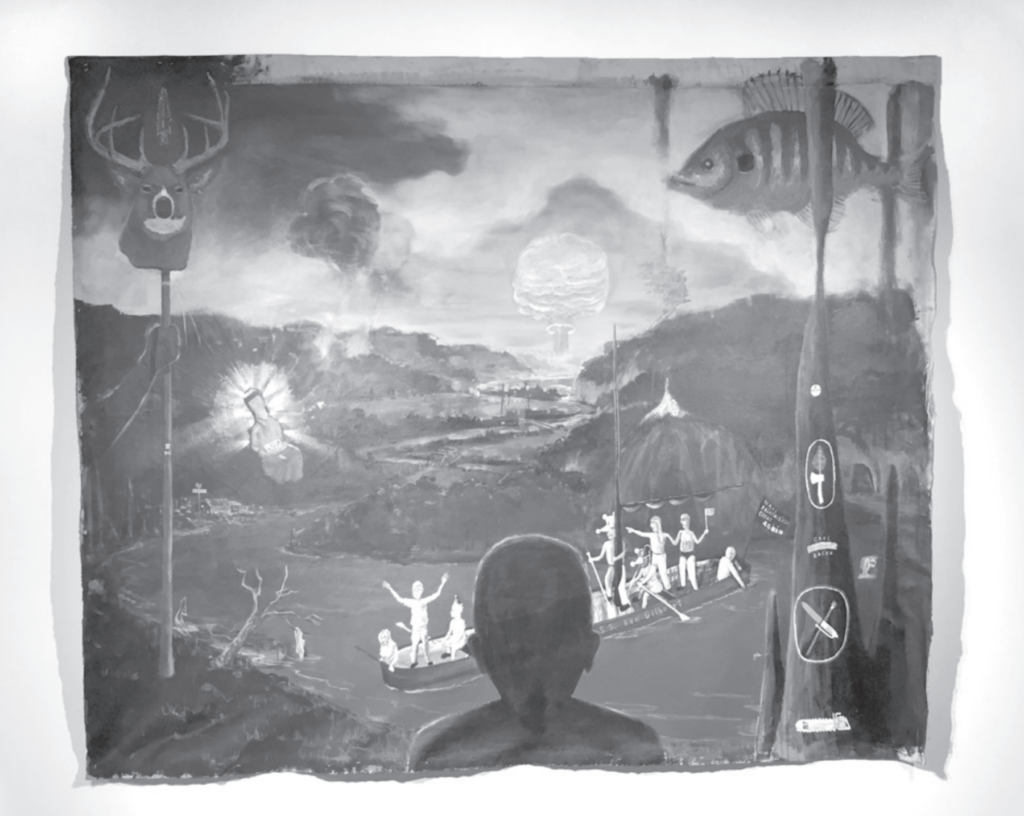Paintallica: Double Vision Quest
Review by Veronica Kavass
Soo Visual Arts Center
Jan 30–July 16, 2016

To be included as an artist in the collective Paintallica, membership appears to require a cock. I base this on my first (and only) visit to the site specific installation Double Vision Quest at Soo Visual Arts Center. Appears is an important word here, because within twenty-four hours of visiting the exhibition, my perspective took a turn regarding the artist collective and the fruits of their collaborative labor. There is more here than meets the eye.
At first glance, the exhibition was rascally, garish, occasionally neon—a watered-down Mike Kelley inspired installation without the foundation of trauma or philosophical depth. In the mess of paintings and sculptures, there were recurring images of bats, chainsaws, cocks, wolves, totem-poles, boats, and Donald Trump. Double Vision Quest didn’t come off as a politically-charged show, but as evidence of lively conversations under the stars, among howling creatures, under the influence, into the dark future.
The map/press release guided my way through titles like Coachella Shangri la la and Fart Garsmuckle and Log Jammin’. The artists who created the installation hail from all over the country, consisting of four Joshes and twelve other males. By the second tour around the gallery, I wrote the collective off as group of fun-loving lumbersexuals who had huge boners for their own work, hid behind cartoonish woodland creatures, and believed women would taint their collective genius.
Before leaving, I returned to A River Runs Through It to study the messianic depiction of a figure named Lydia. She was an infantile old woman floating out from an apocalyptic scene reminiscent of Hieronymus Bosch. This painting offered access to stories and she was a major character.
Who is Lydia?
The gallery director smiled when I asked her this. She told me how Paintallica journeyed to Mystery Cave State Park after they gathered in Minneapolis. They stopped at Ed’s Museum in Wyckoff—a hoarder’s empire that sheltered a human-sized doll named Lydia. “But she’s not like a sex doll or anything,” the director assured.
After Paintallica returned from their field trip, they broke up into pairs and rotated around the gallery, switching out partners to ensure all hands would be involved in each piece of the installation. For several days, they disgorged their experience with the aid of cheap beer, chainsaws, articles of clothing, and the more traditional artist tools.
I wanted to know who the leader of the group was, but she told me the group didn’t exactly have one. Then she gave me the email address of Portland-based Dan Attoe—one of the founders and the group’s mouthpiece.
I emailed Attoe three questions: Is he the leader of the leaderless group? Was Lydia a doll? And why no ladies?
Being removed from the exhibition provided me with a different filter—the memory of what I had just seen amalgamated with the internet’s presentation of Paintallica. As separate individuals, the collective was made up of intelligent, humorous, and talented artists who avoided pretension and encouraged play. Maybe Paintallica was the collective that Henry Darger would’ve been a part of had he been born in Portland or Minneapolis thirty years ago. Accounts of the collective’s adventures caused me to shift from a nah to a yeah, maybe.
Attoe responded that there’s a handful of women in the group—Greta Songe, Posie Currin, and Lorie Gilbert (who was supposed to take part in Double Vision Quest, but couldn’t due to a family emergency)— but he acknowledged there was “no easy answer as to why there were so few.” He considered that nonmale artists who didn’t know the group found them “intimidating.” Paintallica made work that “engaged many psychological, social, cultural, and philosophical [matters] in a very intense free-associative way over a short period of time … Sexuality always comes up, because it’s a part of everyone’s identity, and integrated into culture as well. We often end up poking fun at the clumsy ways sexuality is viewed through culture, and sometimes that can come off kind of rough. Truth is, that women of the group do the same.”
Art that tackles conventions may be perceived as a proponent of those conventions. This is especially the case when art is in your face about what it wants to prove. Maybe Paintallica was confronting masculine, heteronormative culture, but there needed to be more of a critical edge to convince me of that. And more diverse voices in the mix. Incorporating Trump’s face into the assemblage will not do the heavy lifting. The narrative Paintallica is currently spinning is missing vital threads.
Learning the backstory of an artwork and/or artist interferes with my judgement. Sometimes the story is reaffirming, sometimes it proves me wrong. Perhaps this is why so many art historians are against the influence an artist’s biography has on the work. Shouldn’t the work stand alone? As someone who is interested in the intersection of life and work, I continue to seek out backstories, but I recognize the danger.
What is my ultimate impression of the exhibit after taking all of that into account? I once dated someone who saw himself as “the man in the relationship.” When he tried too hard to push his macho agenda on me, I laughed. This caused him to be detumescent, followed by awkward silence. After twenty-four hours of thinking about Paintallica, Double Vision Quest has the same result. They provide evidence of traditional male bonding, but the only non-sexualized female presence in their exhibit is Lydia. And Lydia is a doll.
